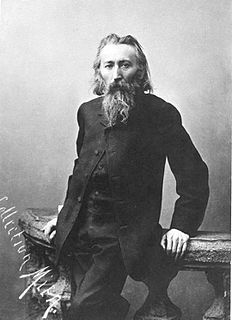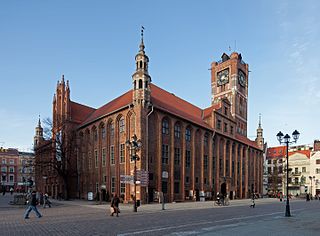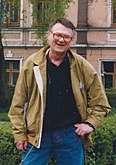
Jan (Alojzy) Matejko was a Polish painter known for paintings of notable historical Polish political and military events. His works include large oil on canvas paintings like Rejtan (1866), Union of Lublin (1869) or Battle of Grunwald (1878), numerous portraits, a gallery of Polish kings, and murals in St. Mary's Basilica, Kraków. He is referred to as the most famous Polish painter or even the "national painter" of Poland.

Young Poland was a modernist period in Polish visual arts, literature and music, covering roughly the years between 1890 and 1918. It was a result of strong aesthetic opposition to the earlier ideas of Positivism which followed the suppression of the 1863 January Uprising against the occupying army of Imperial Russia. Młoda Polska promoted trends of decadence, neo-romanticism, symbolism, impressionism and art nouveau.

The culture of Poland is the product of its geography and distinct historical evolution which is closely connected to its intricate thousand-year history. Polish culture forms an important part of western civilization and the western world, with significant contributions to art, music, philosophy, mathematics, science, politics and literature.

Romanticism in Poland, a literary, artistic and intellectual period in the evolution of Polish culture, began around 1820, coinciding with the publication of Adam Mickiewicz's first poems in 1822. It ended with the suppression of the January 1863 Uprising against the Russian Empire in 1864. The latter event ushered in a new era in Polish culture known as Positivism.

Silesian Museum is a museum in the city of Katowice, Poland.

The Jan Matejko Academy of Fine Arts in Kraków, is a public institution of higher learning located in downtown Kraków, Poland. It is the oldest Polish fine arts academy, established in 1818 and granted full autonomy in 1873.

The National Museum in Kraków, popularly abbreviated as MNK, established in 1879, is the main branch of Poland's National Museum, which has several independent branches with permanent collections around the country. The Museum consists of 21 departments which are divided by art period; 11 galleries, 2 libraries, and 12 conservation workshops. It holds some 780,000 art objects, spanning from classical archeology to modern art, with special focus on Polish painting.

The Gallery of 19th-Century Polish Art at Sukiennice, is a division of the National Museum, Kraków, Poland. The Gallery is housed on the upper floor of the Renaissance Sukiennice Cloth Hall in the center of the Main Market Square in Old Town Kraków.

Toruń Regional Museum, located in the Ratusz hall of Toruń, is one of the oldest and largest museums in Poland. It started in 1594 as the mere Cabinet of Curiosities at the library of the academic Gimnazjum, called Musaeum in Latin. Re-established in sovereign Poland as a city museum in 1920 after the century of military partitions, it was administratively structured as the regional museum in 1965.
The Foksal Gallery or Galeria Foksal is a small non-commercial art gallery in Warsaw, Poland established in 1966, that shows works by contemporary avant-garde artists.

Władysław Łuszczkiewicz was a Polish historical painter of the late Romantic era from Kraków, active in the period of the foreign partitions of Poland. He was a professor at the Academy of Fine Arts and served as its principal in 1893/95. One of his best students was Jan Matejko, the eminent Polish historical painter and later, his close associate. Łuszczkiewicz taught painting, drawing, anatomy and architectural styles. Highly educated, he also worked as conservator of architectural monuments in the city later on in his career, and wrote historical dissertations.

The National Museum in Wrocław, established 28 March 1947 and officially inaugurated on 11 July 1948, is one of Poland's main branches of the National Museum system. It holds one of the largest collections of contemporary art in the country.

Muzeum Sztuki, or the Museum of Art in Łódź is a museum of modern and contemporary art in Łódź, Poland, whose main goal is to research and display avant-garde art, as well as progressive artistic interventions.




















